|
|
|
Sort Order |
|
|
|
Items / Page
|
|
|
|
|
|
|
| Srl | Item |
| 1 |
ID:
094910


|
|
|
|
|
| Publication |
2010.
|
| Summary/Abstract |
This study applies a socio-technical systems perspective to explore innovation dynamics of two emerging energy technologies with potential to reduce greenhouse gas emissions from electrical power generation in the United States: carbon capture and storage (CCS) and enhanced geothermal systems (EGS). The goal of the study is to inform sustainability science theory and energy policy deliberations by examining how social and political dynamics are shaping the struggle for resources by these two emerging, not-yet-widely commercializable socio-technical systems. This characterization of socio-technical dynamics of CCS and EGS innovation includes examining the perceived technical, environmental, and financial risks and benefits of each system, as well as the discourses and actor networks through which the competition for resources - particularly public resources - is being waged.
|
|
|
|
|
|
|
|
|
|
|
|
|
|
|
|
| 2 |
ID:
126490


|
|
|
|
|
| Publication |
2013.
|
| Summary/Abstract |
One of the actions proposed to reduce greenhouse gas (GHG) emissions in South Africa (SA) is to install carbon capture and storage (CCS) at new energy-producing plants. This paper aims to evaluate the costs and GHG emissions of implementing CCS at a coal-fired integrated gasification combined cycle (IGCC) power plant, at a coal fired ultra-supercritical (USC) power plant, at a synthetic fuel coal-to-liquid (CTL) plant and at a gas-to-liquid (GTL) plant for SA. The approach for comparing of these CCS applications is based on a combination of a techno-economic analysis with a life-cycle assessment. As expected, the generating costs in plants with CCS are higher than without CCS for all case studies. GHG-abatement costs in 2040 are shown to be the lowest for the IGCC power plant at 173 ZAR07/t CO2eq, followed by the USC power plant at 227 ZAR07/t CO2eq. These costs are considerably higher for the CTL and GTL plants. The results show that from an economic perspective, CCS might be an attractive option for CO2 mitigation in SA especially for the electricity sector. However, a prerequisite for the implementation of CCS is that the technology reaches commercial scale for the investigated options and is socially accepted.
|
|
|
|
|
|
|
|
|
|
|
|
|
|
|
|
| 3 |
ID:
136242
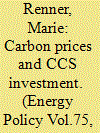

|
|
|
|
|
| Summary/Abstract |
Carbon Capture and Storage is considered as a key option for climate change mitigation; policy makers and investors need to know when CCS becomes economically attractive. Integrating CCS in a power plant adds significant costs which can be offset by a sufficient CO2 price. However, most markets have failed: currently, the weak carbon price threatens CCS deployment in the European Union (EU). In China, a carbon regulation is appearing and CCS encounters a rising interest. This study investigates two questions: how much is the extra-cost of a CCS plant in the EU in comparison with China? Second, what is the CO2 price beyond which CCS plants become more profitable than reference plants in the EU and in China? To address these issues, I conducted a literature review on public studies about CCS costs. To objectively assess the profitability of CCS plants, I constructed a net present value model to calculate the Levelised Cost of Electricity and the breakeven CO2 price. CCS plants become the most profitable plant type beyond 115 €/tCO2 in the EU vs. 45 €/tCO2 in China (offshore transport and storage costs). I advise on the optimal plant type choice depending on the CO2 price in both countries.
|
|
|
|
|
|
|
|
|
|
|
|
|
|
|
|
| 4 |
ID:
093471


|
|
|
|
|
| Publication |
2010.
|
| Summary/Abstract |
China now faces the three hard truths of thirsting for more oil, relying heavily on coal, and ranking first in global carbon dioxide (CO2) emissions. Given these truths, two key questions must be addressed to develop a low-carbon economy: how to use coal in a carbon-constrained future? How to increase domestic oil supply to enhance energy security? Carbon Capture and Storage (CCS) may be a technological solution that can deal with today's energy and environmental needs while enabling China to move closer to a low-carbon energy future. This paper has been developed to propose a possible CCS roadmap for China. To develop the roadmap, we first explore major carbon capture opportunities in China and then identify critical CCS-enabling technologies, as well as analyze their current status and future prospects. We find that coal gasification or polygeneration in combination with CCS could be a nearly unbeatable combination for China's low-carbon future. Even without CCS, gasification offers many benefits: once coal is gasified into syngas, it can be used for many different purposes including for alternative fuels production, thereby increasing the domestic oil supply and the flexibility of the energy system.
|
|
|
|
|
|
|
|
|
|
|
|
|
|
|
|
| 5 |
ID:
101502


|
|
|
|
|
| Publication |
2010.
|
| Summary/Abstract |
The article presents a commercial investment analysis of the carbon capture project at the Kårstø gas processing plant in south-western Norway. We update an earlier analysis and critically review the methods used-including those applied for cost estimating. Our conclusion is that carbon capture and storage (CCS) at Kårstø would be a very unprofitable climate measure with poor cost efficiency. It would require more than USD 1.7 billion in subsidies, or in excess of USD 133 million per year. That corresponds to a subsidy of roughly USD 0.1 per kWh on the power station's electricity output. The cost per tonne of carbon emissions abated is about USD 333, which is about 20 times the international carbon emission allowance price and many times higher than alternative domestic climate measures.
|
|
|
|
|
|
|
|
|
|
|
|
|
|
|
|
| 6 |
ID:
101398


|
|
|
|
|
| Publication |
2011.
|
| Summary/Abstract |
We examined the co-evolution of the transportation, and electricity and heat generation sectors in the Netherlands until 2040 using a MARKAL bottom-up cost optimisation model.
All scenario variants investigated indicate a switch away from crude oil-based diesel and petrol for transportation. Lowest overall CO2 abatement cost is achieved by accommodating transportation first and using relatively expensive options for emissions reduction in electricity generation if needed.
Biomass and carbon capture and storage (CCS) are used to full potential. Transportation CO2 emissions are reduced by switching to ethanol or bio-based synthetic fuels combined with CCS, and series hybrid cars if needed. Depending on the availability of biomass and carbon storage capacity, electricity is produced from biomass, coal with CCS, or wind complemented with natural gas. Indirect greenhouse gas emissions rise to 34-54% of national emissions in 2040.
The difference in annual investment required between the scenario variants with and without CO2 emissions reductions of 68% by 2040 is 4-7 billion euro/year, or 0.5-1.2% of projected GDP.
Investment costs are mostly determined by the cost of cars and electricity generation capacity. We observe competition for limited biomass supply and CO2 storage capacity between the transportation and power sectors.
|
|
|
|
|
|
|
|
|
|
|
|
|
|
|
|
| 7 |
ID:
105759
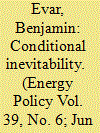

|
|
|
|
|
| Publication |
2011.
|
| Summary/Abstract |
This paper presents findings on expert perceptions of uncertainty in carbon capture and storage (CCS) technology and policy in the UK, through survey data and semi-structured interviews with 19 individual participants. Experts were interviewed in industry, research, and non-governmental organisations (NGOs) in the summer of 2009 and were asked to comment on a range of technical processes as well as policy concerns. The survey revealed that perceptions of the technology conform to a 'certainty trough' with users expressing the lowest level of uncertainty, and outsiders expressing the highest level of uncertainty. The interviews revealed that experts express certitude in the prospects for deploying large-scale CCS technology in the UK, all the while questioning several underlying technical and policy premises that are necessary to ensure this goal.
|
|
|
|
|
|
|
|
|
|
|
|
|
|
|
|
| 8 |
ID:
133294


|
|
|
|
|
| Publication |
2014.
|
| Summary/Abstract |
Large-scale deployment of low-carbon energy technologies is crucial to mitigating climate change, and public support is an important barrier to policies and projects that facilitate deployment. This paper provides insights to the origins of public opposition that can impede the adoption of low-carbon technologies by investigating how perceptions are shaped by local economic interests and individual cultural worldviews. The research considers both carbon capture and storage and wind energy technologies because they differ in maturity, economic impact and resource base. Further, for each technology, the research examines support for two types of policies: deployment in local community and public funding for research and development. Results indicate the influence of economic interests and cultural worldviews is policy specific. Individual cultural worldviews do not affect support for the deployment of technology, but they do significantly influence a person×s support for publicly funded research and development. Conversely, local economic interests have a significant role in determining support for deployment, while they do not affect support for research and development.
|
|
|
|
|
|
|
|
|
|
|
|
|
|
|
|
| 9 |
ID:
109450


|
|
|
|
|
| Publication |
2011.
|
| Summary/Abstract |
A set of 13 US based experts in post-combustion and oxy-fuel combustion CO2 capture systems responded to an extensive questionnaire asking their views on the present status and future expected performance and costs for amine-based, chilled ammonia, and oxy-combustion retrofits of coal-fired power plants. This paper presents the experts' responses for technology maturity, ideal plant characteristics for early adopters, and the extent to which R&D and deployment incentives will impact costs. It also presents the best estimates and 95% confidence limits of the energy penalties associated with amine-based systems. The results show a general consensus that amine-based systems are closer to commercial application, but potential for improving performance and lowering costs is limited; chilled ammonia and oxy-combustion offer greater potential for cost reductions, but not without greater uncertainty regarding scale and technical feasibility.
|
|
|
|
|
|
|
|
|
|
|
|
|
|
|
|
| 10 |
ID:
150791


|
|
|
|
|
| Summary/Abstract |
China is very active in the research and development of CO2 capture and storage technologies (CCS). However, existing estimates for CO2 storage capacity are very uncertain. This uncertainty is due to limited geological knowledge, a lack of large-scale research on CO2 injection, and different assessment approaches and parameter settings. Hence storage scenarios represent a method that can be used by policy makers to demonstrate the range of possible storage capacity developments, to help interpret uncertain results and to identify the limitations of existing assessments. In this paper, three storage scenarios are developed for China by evaluating China-wide studies supplemented with more detailed site- and basin-specific assessments. It is estimated that the greatest storage potential can be found in deep saline aquifers. Oil and gas fields may also be used. Coal seams are only included in the highest storage scenario. In total, the scenarios presented demonstrate that China has an effective storage capacity of between 65 and 1551 Gt of CO2. Furthermore, the authors emphasise a need for action to harmonise storage capacity assessment approaches due to the uncertainties involved in the capacity assessments analysed in this study.
|
|
|
|
|
|
|
|
|
|
|
|
|
|
|
|
| 11 |
ID:
181433
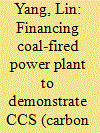

|
|
|
|
|
| Summary/Abstract |
Traditional policy incentives for carbon capture and storage (CCS) mainly rely on fiscal subsidies, which tend to put an inordinate strain on public finances. This study attempts to explore a non-fiscal incentive policy, granting a time extension (extra electricity quota), to finance early CCS demonstration projects in China. We find that coal-fired power plant (CFPP) operate at a loss even without CCS retrofitting under the current electricity quota (4000 h per year), while it can make profits with CCS retrofitting if extra electricity quotas are provided. Specifically, the electricity quota needs to be roughly 4709–7260 h per year with the CO2 capture level ranging from 0.1 to 1 Mt per year in the demonstration stage. In particular, the levelized cost of electricity (LCOE) of CFPP with a capture level of 1 Mt per year is estimated at 298.8 CNY/MWh if the electricity quota reaches 7000 h per year, which is approximately equal to that of CFPP without CCS retrofitting and extra electricity quota (292.2 CNY/MWh). Thus, the extra electricity quota can be considered as an economically feasible policy incentive, and related results are able to provide useful information for electric power enterprises and government decision-makers.
|
|
|
|
|
|
|
|
|
|
|
|
|
|
|
|
| 12 |
ID:
088214


|
|
|
|
|
| Publication |
2009.
|
| Summary/Abstract |
Closing the gap between carbon dioxide capture and storage (CCS) rhetoric and technical progress is critically important to global climate mitigation efforts. Developing strong international cooperation on CCS demonstration with global coordination, transparency, cost-sharing and communication as guiding principles would facilitate efficient and cost-effective collaborative global learning on CCS, would allow for improved understanding of the global capacity and applicability of CCS, and would strengthen global trust, awareness and public confidence in the technology
|
|
|
|
|
|
|
|
|
|
|
|
|
|
|
|
| 13 |
ID:
132931
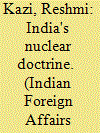

|
|
|
|
|
| Publication |
2014.
|
| Summary/Abstract |
The aim of India's nuclear deterrence capability has been to safeguard itself against blackmail and coercive diplomacy of adversaries. Its doctrinal principles of minimum nuclear deterrence and NFU are consistent with India's declaration of a modest nuclear weapons policy. The official announcements, in the aftermath of the May 1998 tests indicated that India has set out on a pragmatic course of action. Sixteen years after the tests, the Indian government's policies reflect this approach substantially.
|
|
|
|
|
|
|
|
|
|
|
|
|
|
|
|
| 14 |
ID:
192722


|
|
|
|
|
| Summary/Abstract |
Bioenergy with carbon capture and storage (BECCS) can be a useful and cost-effective climate change mitigation tool but it is reliant on economic incentives. With this policy perspective article we question the ongoing discussion about the use of biomass for BECCS with basis in three points: (1) under the enhanced transparency framework under the Paris agreement, all parties to the agreement will use the same guidelines to estimate emissions by sources and removals by sinks, in which the emissions and removals in connection to cultivation of biomass are accounted for in the land-use, land-use change and forestry (LULUCF) sector, (2) adding carbon capture to existing processes may lead to a shift in products from that process rather than an increase in biomass use, and (3) BECCS requires substantial financial incentives. With basis in these points, we argue that a certification framework for BECCS that contradicts the guidelines of the Intergovernmental Panel on Climate Change (IPCC) risks unnecessarily hindering deployment of a potentially cost-effective climate change mitigation tool.
|
|
|
|
|
|
|
|
|
|
|
|
|
|
|
|
| 15 |
ID:
094212
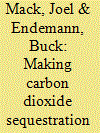

|
|
|
|
|
| Publication |
2010.
|
| Summary/Abstract |
As the United States moves closer to a national climate change policy, it will have to focus on a variety of factors affecting the manner in which the country moves toward a future with a substantially lower carbon footprint. In addition to encouraging renewable energy, smart grid, clean fuels and other technologies, the United States will need to make substantial infrastructure investments in a variety of industries. Among the significant contributors to the current carbon footprint in the United States is the use of coal as a major fuel for the generation of electricity. One of the most important technologies that the United States can employ to reduce its carbon footprint is to sequester the carbon dioxide ("CO2") from coal-fired power plants. This article focuses on the legal and policy issues surrounding a critical piece of the necessary sequestration infrastructure: CO2 pipelines that will carry CO2 from where it is removed from fuel or waste gas streams to where it will be sequestered. Ultimately, this article recommends developing a federally regulated CO2 pipeline program to foster the implementation of carbon sequestration technology.
|
|
|
|
|
|
|
|
|
|
|
|
|
|
|
|
| 16 |
ID:
122741


|
|
|
|
|
| Publication |
2013.
|
| Summary/Abstract |
A great challenge China's power sector faces is to mitigate its carbon emissions whilst satisfying the ever-increasing power demand. Optimal planning of the power sector with consideration of carbon mitigation for a long-term future remains a complex task, involving many technical alternatives and an infinite number of possible plants installations, retrofitting, and decommissioning over the planning horizon. Previously the authors built a multi-period optimization model for the planning of China's power sector during 2010-2050. Based on that model, this paper executed calculations on the optimal pathways of China's power sector with two typical decision-making modes, which are based on "full-information" and "limited-information" hypothesis, and analyzed the impacts on the optimal planning results by two typical types of carbon tax policies including a "continuous and stable" one and a "loose first and tight later" one. The results showed that making carbon tax policy for long-term future, and improving the continuity and stability in policy execution can effectively help reduce the accumulated total carbon emissions, and also the cost for carbon mitigation of the power sector. The conclusion of this study is of great significance for the policy makers to make carbon mitigation policies in China and other countries as well.
|
|
|
|
|
|
|
|
|
|
|
|
|
|
|
|
| 17 |
ID:
111325


|
|
|
|
|
| Publication |
2012.
|
| Summary/Abstract |
Power sector is the largest CO2 emitter in China. To mitigate CO2 emissions for the power sector is a tough task, which requires implementation of targeted carbon mitigation policies. There might be multiple forms for carbon mitigation policies and it is still unclear which one is the best for China. Applying a superstructure optimisation model for optimal planning of China's power sector built by the authors previously, which was based on real-life plants composition data of China's power sector in 2009, and could incorporate all possible actions of the power sector, including plants construction, decommission, and application of carbon capture and sequestration (CCS) on coal-fuelled plants, the implementation effects of three carbon mitigation policies were studied quantitatively, achieving a conclusion that the so-called "Surplus-Punishment & Deficit-Award" carbon tax policy is the best from the viewpoint of increasing CO2 reduction effect and also reducing the accumulated total cost. Based on this conclusion, the corresponding relationships between CO2 reduction objectives (including the accumulated total emissions reduction by the objective year and the annual emissions reduction in the objective year) were presented in detail. This work provides both directional and quantitative suggestions for China to make carbon mitigation policies in the future.
|
|
|
|
|
|
|
|
|
|
|
|
|
|
|
|
| 18 |
ID:
132759
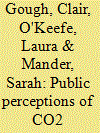

|
|
|
|
|
| Publication |
2014.
|
| Summary/Abstract |
This paper explores the response by members of the lay public to the prospect of an onshore CO2 pipeline through their locality as part of a proposed CCS development and presents results from deliberative Focus Groups held along a proposed pipeline route. Although there is a reasonable level of general knowledge about CO2 across the lay public, understanding of its specific properties is more limited. The main concerns expressed around pipelines focused on five areas: (i) safe operation of the pipeline; (ii) the risks to people, livestock and vegetation arising from the leakage of CO2 from the pipeline; (iii) the innovative and 'first of its kind× nature of the pipeline and the consequent lack of operational CO2 pipelines in the UK to demonstrate the technology; (iv) impacts on coastal erosion at the landfall site; and (v) the potential disruption to local communities during pipeline construction. Participants expressed scepticism over the motivations of CO2 pipeline developers. Trust that the developer will minimise risk during the route selection and subsequent construction, operation and maintenance of the pipeline is key; building trust within the local community requires early engagement processes, tailored to deliver a variety of engagement and information approaches.
|
|
|
|
|
|
|
|
|
|
|
|
|
|
|
|
| 19 |
ID:
098627


|
|
|
|
|
| Publication |
2010.
|
| Summary/Abstract |
To explore public awareness of carbon capture and storage (CCS), attitudes towards the use of CCS and the determinants of CCS acceptance in China, a study was conducted in July 2009 based on face-to-face interviews with participants across the country. The result showed that the awareness of CCS was low among the surveyed public in China, compared to other clean energy technologies. Respondents indicated a slightly supportive attitude towards the use of CCS as an alternative technology to CO2 emission reductions. The regression model revealed that in addition to CCS knowledge, respondents' understanding of the characteristics of CCS, such as the maturity of the technology, risks, capability of CO2 emission reductions, and CCS policy were all significant factors in predicting the acceptance of CCS. The findings suggest that integrating public education and communication into CCS development policy would be an effective strategy to overcome the barrier of low public acceptance.
|
|
|
|
|
|
|
|
|
|
|
|
|
|
|
|
| 20 |
ID:
117256


|
|
|
|
|
| Publication |
2013.
|
| Summary/Abstract |
Carbon capture and storage (CCS) has the potential to play a major role in the stabilization of anthropogenic greenhouse gases. To develop the capture technology from its current demonstration phase towards commercial maturity, significant funding is directed to CCS, such as the EU's €4.5 bn NER300 fund. However, we know little about how this funding relates to market diffusion of CCS. This paper addresses that question. We initially review past learning effects from both capacity installations and R&D efforts for a similar technology using the concept of two-factor learning. We apply the obtained learning-by-doing and learning-by-searching rates to CCS in the electricity market model Hector, which simulates 19 European countries hourly until 2040, to understand the impact of learning and associated policies on CCS market diffusion. We evaluate the effectiveness of policies addressing learning-by-doing and learning-by-searching by relating the policy budget to the realized CCS capacity and find that, at lower policy cost, both methods are about equally effective. At higher spending levels, policies promoting learning-by-doing are more effective. Overall, policy effectiveness increases in low CO2 price scenarios, but the CO2 price still remains the key prerequisite for the economic competitiveness, even with major policy support.
|
|
|
|
|
|
|
|
|
|
|
|
|
|
|
|
|
|
|
|
|